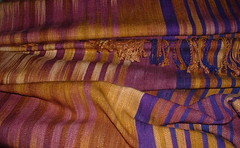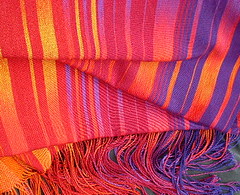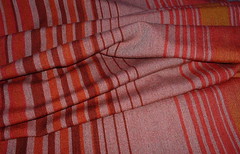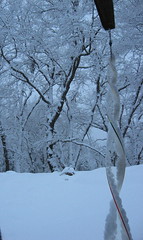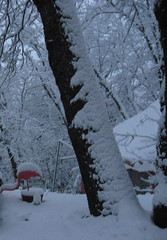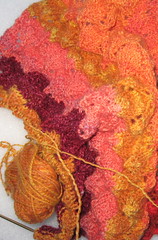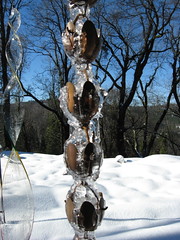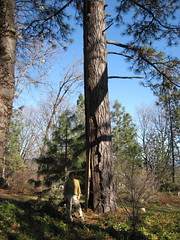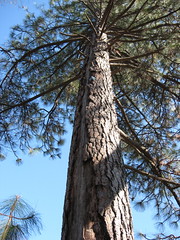Next Time I Get A Red Cat
Brrrrrr. Cold and grey out there. I've been knitting a Great Grey Slog for many months, on this:
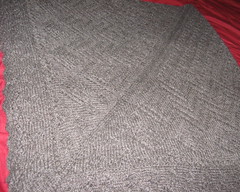
the cat blanket,to match the cat:
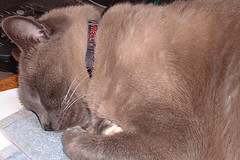
He seems to leave grey cat hair on every knitted object, so I made him one of his own, from handspun Coopworth from Sue's flock up the street. I *designed* the pattern, if you can call it that. It's really just plugging in pattern shapes where they will fit. I started with the cat paws part, then added snakes:

because some un-named rascal likes to hunt them and bring them inside for all to enjoy. Next, there are bushes:

in which the snakes and mice hide, followed by a border of mice, which were not as successful as I'd have liked. But I really like the cat prints creeping around the edge:
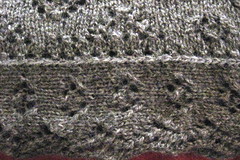
I couldn't find an edging pattern with cat prints on it, so I made one up. I botched the corners of the edging, which I just slogged around, in keeping with the greyness and slogginess of the project. I will rethink "corners" next time, but not on this grey slog of a blanket. Stick a fork in it, it's done.
You know the end of this story as surely as I do: he will probably eschew *his* personal blanket, and continue to leave an ethereal grey dusting of cat hair over all my other blankets, strategically placed in apparently every cat-friendly spot in the house.
This is up next, for some sort of lace shawl or scarf, it's Polwarth:
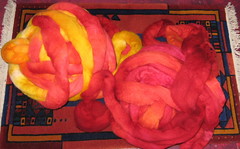
Can you tell I've been denied color? I was inspired by some Mountain Colors yarn, a new series that is two separate colors in the singles, plied together. It's easy for a spinner to do that, but quite confusingly odd to find it in commercial yarns. The Mountain Colors yarn is making it's debut at Stitches West this weekend, but we saw a preview while Dee worked up a sample pattern.
The red, orange and gold colors are all sunshine and warmth, and cheer a winter weary heart. Last year we had a Mexican trip to break up the long grey winter, not so this year. But next year, we're leaving winter behind, and following the summer. Hooray!

the cat blanket,to match the cat:

He seems to leave grey cat hair on every knitted object, so I made him one of his own, from handspun Coopworth from Sue's flock up the street. I *designed* the pattern, if you can call it that. It's really just plugging in pattern shapes where they will fit. I started with the cat paws part, then added snakes:

because some un-named rascal likes to hunt them and bring them inside for all to enjoy. Next, there are bushes:

in which the snakes and mice hide, followed by a border of mice, which were not as successful as I'd have liked. But I really like the cat prints creeping around the edge:

I couldn't find an edging pattern with cat prints on it, so I made one up. I botched the corners of the edging, which I just slogged around, in keeping with the greyness and slogginess of the project. I will rethink "corners" next time, but not on this grey slog of a blanket. Stick a fork in it, it's done.
You know the end of this story as surely as I do: he will probably eschew *his* personal blanket, and continue to leave an ethereal grey dusting of cat hair over all my other blankets, strategically placed in apparently every cat-friendly spot in the house.
This is up next, for some sort of lace shawl or scarf, it's Polwarth:

Can you tell I've been denied color? I was inspired by some Mountain Colors yarn, a new series that is two separate colors in the singles, plied together. It's easy for a spinner to do that, but quite confusingly odd to find it in commercial yarns. The Mountain Colors yarn is making it's debut at Stitches West this weekend, but we saw a preview while Dee worked up a sample pattern.
The red, orange and gold colors are all sunshine and warmth, and cheer a winter weary heart. Last year we had a Mexican trip to break up the long grey winter, not so this year. But next year, we're leaving winter behind, and following the summer. Hooray!
